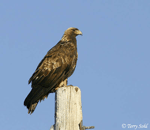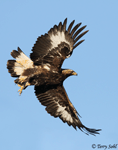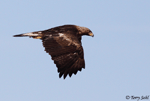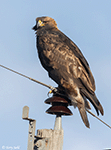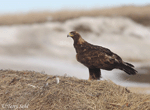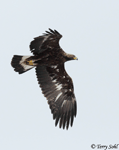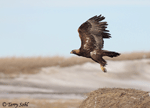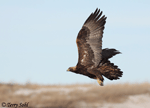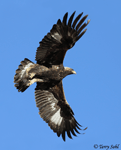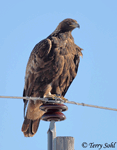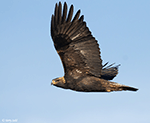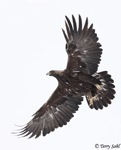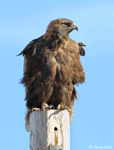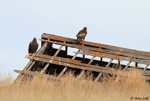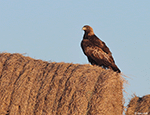| Length: 30 - 36 inches | Wingspan: 6 - 8 feet | Seasonality: All Seasons / Winter |
| ID Keys: Large size, dark brown overall, lighter "golden" crown | ||
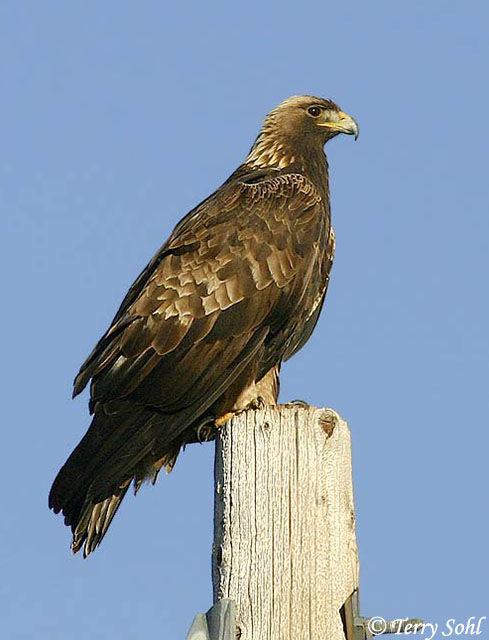 Golden
Eagles are magnificent, powerful raptors, the largest of all birds of prey found
in North America. Generally found in the
western half of the U.S. (although it is an uncommon resident of the East),
the Golden Eagle is a hunter of wide open prairies. They are also found in
much of Europe and Asia. Golden Eagles are generally solitary birds, and
are not often found in the large groups that Bald
Eagles are sometimes found. In summer in South Dakota, they are found in a
few select areas of the far western part of the state where suitable nesting
sites are found. They are spread more widely in winter, where they can be found
patrolling the grasslands of the central part of the state.
Golden
Eagles are magnificent, powerful raptors, the largest of all birds of prey found
in North America. Generally found in the
western half of the U.S. (although it is an uncommon resident of the East),
the Golden Eagle is a hunter of wide open prairies. They are also found in
much of Europe and Asia. Golden Eagles are generally solitary birds, and
are not often found in the large groups that Bald
Eagles are sometimes found. In summer in South Dakota, they are found in a
few select areas of the far western part of the state where suitable nesting
sites are found. They are spread more widely in winter, where they can be found
patrolling the grasslands of the central part of the state.
Habitat:
Given their wide distribution in both the Eastern and Western Hemispheres, a very wide variety of habitats may be occupied. In the United States, they may be find in a wide range of habitats but generally are found in open country, including prairie, rangeland, desert, or tundra.
Diet:
Primarily small mammals. They will also occasional take larger prey such as young deer or pronghorn, with some mated pairs seemingly specializing in the take down of certain larger creatures. Opportunistic feeders, other prey items include birds, snakes, lizards, and carrion.
Behavior:
Will look for prey while soaring, while observing from a perch, or by swooping low over the ground. Pairs will sometimes cooperatively hunt, particularly with larger prey, where both birds may take turns chasing and wearing prey out before moving in for the final kill. Many breeding pairs may mate for life.
Nesting:
March through June in South Dakota. The nest of a Golden Eagle is a very large structure primarily made up of branches and sticks, but with a wide variety of other materials related to the breeding area. Other nest materials used to line the interior of the nest may include roots, grasses, leaves, and bits of fur and feathers. The nest may be placed in a variety of locations, including cliff faces, on man-made structures such as bridges or towers, or on the ground. Two eggs are laid, and the female alone does most of the incubation. The incubation period is about 6 weeks. Young take their first flight 2 months or more after hatching, but generally stay in the care of the parents for many weeks after fledging.
Song:
Generally silent at most times of the year, but they do have occasional calls or courting vocalizations.
- Click here to hear vocalizations of young begging at a nest site1
- Click here to hear a "song" of courting Golden Eagles2
- Click here to hear an alarm call3
Migration:
Birds in northern part of their range (northern half of Canada, and Alaska) may move south in the fall. Many birds in the western U.S. are permanent residents.
Interactive eBird Map:
Click here to access an interactive eBird map of Golden Eagle sightings
Similar Species:
Size alone distinguishes Golden Eagles from other raptors, as they are massive birds. The golden head mantle also distinguishes them. The one species that could potentially be confused with them is the Bald Eagle. Adult Bald Eagles are obviously different, with the all white head and tail. However, juveniles have dark plumage without the white head and tail, and could be confused with Golden Eagles. The patterns of white on a juvenile Bald Eagle distinguish it from a Golden Eagle. Note Golden Eagle adults have no white in the plumage, so an all dark bird is a Golden Eagle. Immature Golden Eagles have a distinct and broad white patch on the tail, and two distinct white wing patches. Conversely, immature Bald Eagles have patchy white feathering scattered throughout, including on the wing linings as seen from underneath, an area that's dark on Golden Eagles of all plumages.
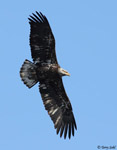 |
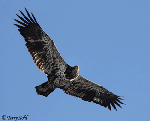 |
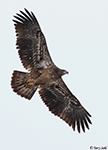 |
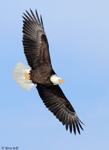 |
| Bald Eagle (immature) | Bald Eagle (immature) | Bald Eagle (immature) | Bald Eagle (adult) |
Conservation Status:
Currently stable, although numbers are lower than historical levels (especially in the Eastern U.S.). At a global level, the IUCN considers the Golden Eagle to be a species of "Least Concern".
South Dakota "Hotspot":
They are very often found on the Fort Pierre National Grasslands in winter. The Kennebec/Presho/Reliance corridor along I-90 is one location in winter where I often find Golden Eagles, particularly an area about 5 miles southwest of Presho where I always seem to find a massive mature pair in winter.
Further Information:
- USGS Patuxent Bird Identification InfoCenter, Golden Eagle
- National Geographic - Golden Eagle
- Audubon Guide - Golden Eagle
Photo Information:
February 1st, 2005 -- Lyman County near Lyman -- Terry L. Sohl
Additional Photos:
Click on the image chips or text links below for additional, higher-resolution Golden Eagle photos.
Audio File Credits:
- 1Patrik Aberg, XC449073. Accessible at www.xeno-canto.org/449073.
- 2Lauri Hallikainen, XC233241. Accessible at www.xeno-canto.org/233241
- 3Lars Edenius, XC453324. Accessible at www.xeno-canto.org/453324
| Click on the range map for a higher-resolution view |
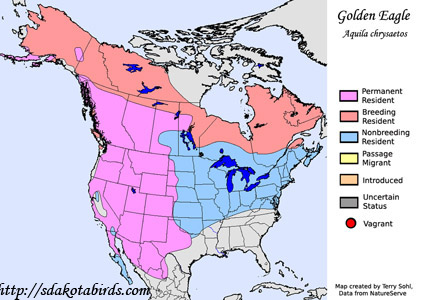 |
| South Dakota Status: Uncommon permanent resident in the western part of the state. Rare winter visitor in the east. |
Additional Golden Eagle Photos
Click for a higher-resolution version of these photos
